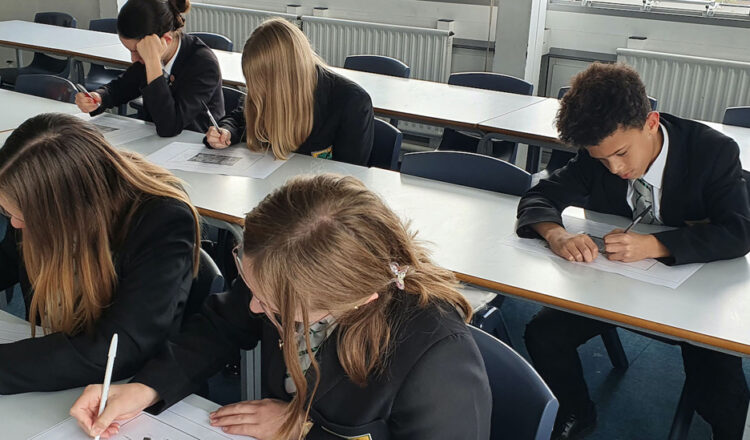Why should you bother listening to your students? Neil Bates teamed up with colleague Robbie Bowry to allow their students to help guide and shape some of the department’s lessons and historical enquiries.
If your experience of student voice or student council is anything like ours, you’ll no doubt recognise the usual complaints:
“The toilets are awful!”
“The food in the school canteen is nasty!”
“We want to go on more trips!”
While we would never seek to argue that clean toilets, decent food and the odd trip are not important parts of school life, we would suggest that student voice can be part of a much richer dialogue.
A dialogue that can be 100% focussed upon improving our History lessons and making students active contributors to the development of our curricula.
Full disclosure; these ideas are the original brain child of Dr Anna Pendry of Oxford University and formed part of her workshop at the SHP Conference in 2009. What we have attempted to do is put her original proposals into practise.
The basic theory of this approach to student voice is to allow a small group of students to have an input into the writing of new historical enquiries and allow them to then observe the lesson as it is taught and provide feedback to the teacher.
After all, the National Curriculum for History at KS3 does require us to allow students to construct their own enquiries.
Why bother?
Admittedly, the whole idea might sound like a recipe for disaster. However, we would argue that by following a logical sequence we should be able to harness the power of student creativity and honesty to help us craft better learning experiences.
The students we all teach are completing lesson observations and evaluations of our teaching, our delivery, our explanations and our resources every single day.
Every child has an opinion about our lessons and they will share their thoughts with their peers and parents.
This approach seeks to utilise those opinions as a tool to departmental improvement.
But I’m the expert!
True. You are the expert and at no point would we ever argue that this process should be some anarchistic free-for-all in which teacher expertise is sublimated to student whims.
This process seeks to keep the spirit of historical enquiry front and centre and enhance it with student input. (We do however tip our hats to some of the pioneers in the 70s Anarchist Free School movement; maybe not as inspiration for this work but just because they had the guts to try something different).
So, how does it work?
Step 1: Recruit your team.
We decided to start small and invite about a dozen students to have a meeting with us. Keeping it small allowed us to foster a seminar/workshop feel as opposed it feeling like another lesson.
In the beginning we hand-picked students who we felt were:
- Interested in history
- Reasonably articulate
- Would buy in to the process
Once this was done we simply invited them to a meeting and outlined the plan.
Step 2: The Plan.
The plan is relatively simple. We met our team and explained that as a department we wanted to involve them in the planning of new lessons/enquiries and as such would greatly appreciate their feedback.
The next step was to take a historical enquiry that the department was currently working on and show it to the students. In our case it was some work on a local archaeological dig site.
We presented the lesson to the students and, in doing, so explained our intention for each stage of the enquiry. The students then began to offer their feedback.
This feedback section is the main reason for attempting this sort of work. It allowed us, as teachers, to see the enquiry from the other side of the desk. We quickly became aware this process allowed us to:
- Hear which bits students found engaging.
- Sharpen our explanations in front of a friendly audience
- Avoid the Curse of Knowledge- that moment when we as teachers (because we know the material really, really well) make assumptions about student understanding.
Step 3: Revise, teach and get feedback
The next stage was for us to take on board the ideas the student voice group had raised and implement the ones we felt were valid into our planning.
It is worth noting here that we did accept several ideas, we rejected some and we reached a happy compromise on others.
However, throughout the process the students reported that they felt that the important thing was their involvement.
Following this, we taught the lesson and asked members of the Student Voice Group to complete a lesson feedback form to see if their experience of the actual lesson met with the aims we had outlined in the initial meeting.
For this phase we wanted students to have a simple lesson observation form and also wanted them to create it themselves.
To this end we chose to discuss Rosenshine’s principles of instruction with the group.
We chose to do this not because it suddenly became trendy for schools to have posters of the Principles of Instruction everywhere, but because we felt it was a simple tool that students could grasp and make use of to design their feedback sheet.

Other Considerations
Dr Pendry was always at pains for teachers (and particularly SLT) to understand that this was not a programme of Spies in the Classroom. We would concur.
The second you make this about anything other than interested students discussing history and how they learn, the project is dead.
There may be a time lag between initial meetings and the actual teaching of the lesson. This is often unavoidable.
Equally, it may be that you are working on an enquiry for Year 7 and your initial team is all Year 8.
Two possible solutions are firstly, to recruit across the Key Stages.
Secondly, you might be able to have a couple of students off-timetable to observe you with a different year group.
In our experience, these meetings are best held after school rather than at break time.
The discussion needs room to breathe and you don’t want to be looking at the clock every few minutes or expecting the next class to come through the door and demand you teach them.
A word from our sponsors
We thought it would be a pretty poor article on student voice if it didn’t include any actual student voice. So, we asked our team for their feedback. Their words are reproduced here without edits:
“To have feedback on what students actually think about the lessons, not about whether they like the teachers.”
“So you know what we are actually taking in and learning rather than just moving on to the next lesson.”
“So you can filter out the boring bits and see what will actually intrigue us.”
“It helps you to have feedback on the actual activities of the lessons (rather than just on the resources).”
The student team also came up with their checklist for running student voice activities. While it replicates some of the points made earlier, we felt it was worth reproducing in full:
- Pick students who care about their learning and will want to take part.
- Students need to have a level of confidence – because you need to speak out BUT, it can build confidence as a small group environment is safe and they will feel able to speak up and give opinions.
- Teachers need to explain the why the lesson is done in a certain way (rather than just ask “is it a good lesson?”)
- Students will be more honest (potentially) as they aren’t influenced by how they would teach it. They have no preconceived ideas about what they would do.
- An atmosphere of mutual respect.
- The teacher and the students both need good questioning skills- ask follow up questions!
- Allow plenty of time for the students to really think about the lesson/enquiry before feeding back.
- Run it, run it again with feedback, re-work it, run it again.
If anyone would like any further details about how we at Harrow Way Community School are implementing Student Voice in the History Classroom, please get in touch.


Lead History Teacher at Harrow Way Community School, Andover, Hampshire.






